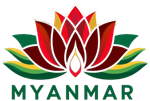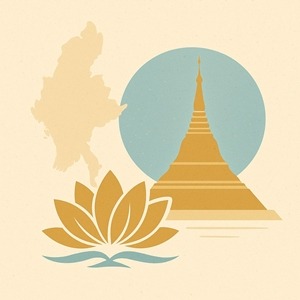
Mon State: People, History, and Culture of One of Myanmar’s Oldest Civilizations
Mon State, located in southern Myanmar along the Andaman Sea, is one of the country’s most historically influential and culturally vibrant regions. Home to the Mon people, who are among the earliest known civilizations in mainland Southeast Asia, the state boasts ancient kingdoms, golden pagodas, delicious cuisine, breathtaking natural landscapes, and deeply rooted traditions that have shaped Myanmar’s cultural identity for over a millennium.
From the legendary city of Suvannabhumi to the magnificent Kyaiktiyo Golden Rock, Mon State stands as a symbol of resilience, spirituality, and legacy.
Geographical Setting
Mon State lies between Yangon Region to the north and Tanintharyi Region to the south. It shares a long coastline with the Andaman Sea, giving the region maritime wealth, port settlements, and fishing communities. Its two major cities—Mawlamyine (formerly Moulmein) and Thaton—serve as cultural and economic hubs.
The state is characterized by:
lush lowlands ideal for rice cultivation
limestone mountains and caves
long coastlines with mangroves and sandy beaches
major rivers like the Thanlwin (Salween) and Gyaing
hilly landscapes surrounding the Kyaiktiyo Pagoda area
The tropical climate provides warm temperatures year-round, with heavy monsoon rains supporting agriculture and greenery.
The Mon People: One of Southeast Asia’s Earliest Civilizations
The Mon people have a long and distinguished history. They were among the first to bring Theravada Buddhism to the region, influencing the spiritual and cultural structures of present-day Myanmar and Thailand.
Language and Identity
The Mon language belongs to the Mon-Khmer branch of the Austroasiatic family, related to Khmer (Cambodian). It has its own script, which historically influenced the Burmese alphabet. The Mon people are known for their gentle manners, respect for tradition, and deeply Buddhist lifestyle.
Today, Mon communities live widely across Mon State, Kayin State, and parts of Thailand, yet they continue to preserve their language, weaving, rituals, and customs.
Ancient History: Suvannabhumi and the Rise of Mon Kingdoms
Mon State’s history is intertwined with legendary civilizations that flourished long before the rise of Bagan or Ayutthaya.
Suvannabhumi (Golden Land)
Historical and archaeological evidence suggests that the ancient kingdom of Suvannabhumi—meaning “Golden Land”—was located in the region around Thaton. The Mon people played a central role in this civilization, which served as a major center for Buddhism, maritime trade, and art.
Thaton Kingdom
The Thaton Kingdom (Thuwunnabumi) flourished until 1057, when King Anawrahta of Bagan conquered it. Thaton had extensive contacts with Sri Lanka and India, importing Buddhist scriptures, architecture, painting styles, and monastic traditions.
This cultural exchange helped shape Bagan’s own golden age and left a lasting legacy on Myanmar’s religious landscape.
Hanthawaddy (Bago) Kingdom
After the fall of Thaton, the Mon reestablished their power in Lower Myanmar and founded the Hanthawaddy Kingdom with Bago as its capital. This era is considered one of the greatest Mon achievements, known for:
flourishing arts and literature
grand pagoda construction
the spread of Theravada Buddhism
maritime trade with India, China, and Siam
Mon artisans and architects profoundly influenced Burmese culture during this period.
Religion and Spiritual Life
Like most Mon people, the population in Mon State practices Theravada Buddhism. Mon Buddhism is known for its purity, discipline, and close connection to Sri Lankan traditions.
Key Religious Practices
Daily alms-giving
Offering lotus flowers and candles at pagodas
Observing Buddhist Lent
Chanting Pali scriptures
Building sand pagodas during certain festivals
The Mon are recognized for their dedication to preserving ancient Buddhist texts and rituals.
Landmarks and Sacred Sites
Mon State is home to some of Myanmar’s most iconic religious landmarks.
1. Kyaiktiyo Pagoda (Golden Rock)
One of the most sacred pilgrimage sites in Myanmar, Kyaiktiyo Pagoda sits atop a granite boulder covered in gold leaf, appearing to defy gravity. According to legend, it balances on a single hair of the Buddha. Pilgrims from across the country hike up the mountain to pray, meditate, and pay their respects.
2. Mawlamyine
The state capital is known for:
the spectacular Kyaikthanlan Pagoda, immortalized by Rudyard Kipling
colonial-era buildings
the vantage point of Zwegabin Hill across the river
Buddhist monasteries and local markets
Mawlamyine was once the capital of British Burma and remains a melting pot of cultures.
3. Win Sein Taw Ya Reclining Buddha
Located near Mudon, this is one of the largest reclining Buddha statues in the world, with an interior filled with dioramas illustrating Buddhist teachings.
4. Thanbyuzayat War Cemetery
A memorial site for Allied prisoners of war who died while building the Burma–Thailand Railway (Death Railway) during World War II.
5. Kyaikkhami Yele Pagoda
A unique pagoda complex built on small islands by the sea, connected by bridges. During high tide, parts of the structure appear to float.
6. Hpa-An and Surroundings (Culturally Connected)
Although technically in Kayin State, many Mon cultural traditions influence the area. Kawgun Cave, filled with ancient Mon Buddhist carvings from the 7th century, is a major example.
Culture, Traditions, and Festivals
Mon State is known for its vibrant cultural life, distinctive traditions, and lively festivals.
Mon National Day
Celebrated on the first waning day of the lunar month of Tabodwe, this holiday commemorates the founding of the ancient Mon kingdom. Festivities include:
parades in red-and-white Mon attire
traditional dances
boat races
literature readings
cultural performances
Thingyan (Water Festival) – Mon Style
While Myanmar celebrates Thingyan nationwide, the Mon version features:
traditional drum performances
dances in colorful Mon dress
ceremonial offerings
special Mon snacks and sweets
Kathina Festival
A Buddhist festival marking the end of Lent. Villagers donate robes and alms to monks, celebrating with processions and music.
Traditional Music and Dance
Mon music uses distinctive instruments such as:
Kyam (Mon harp)
Saung
Mon drums
Ozi and Dobat
Mon dances often depict historical battles, court life, or Buddhist stories.

Traditional Clothing
Mon traditional dress is elegant, simple, and symbolic.
Mon Women
Wear white blouses and long skirts with red borders
Adorn their hair with fresh flowers
Use natural makeup and subtle jewelry
Mon Men
Wear white shirts and red-checkered longyis
Sometimes don turbans during ceremonies
These clothing styles are especially prominent during festivals and cultural events.
Cuisine of Mon State
Mon cuisine is famous for its fresh ingredients, sour flavors, and coastal influence.
Signature Mon Dishes:
Mon fish soup (Mon Nga Hnang) – spicy, sour fish broth
Hta-min Chin (sour rice) – fermented rice eaten with fried fish and vegetables
Mon Mohinga – a lighter, tangier version of Myanmar’s national dish
Seafood curries – prawns, squid, and crab cooked with Mon spices
Khong Nyot – sticky rice desserts flavored with palm sugar
Mon food reflects the region’s coastal environment and ancient cultural heritage.
Economy and Local Industries
The economy of Mon State is diverse:
Agriculture
Rice
Rubber
Betel nut
Fruits (durian, rambutan, mangosteen)
Vegetables
Mon durians are especially famous nationwide.
Fishing and Marine Products
With its long coastline, Mon State thrives on:
fish farming
shrimp and crab harvesting
dried seafood production
Tourism
Popular attractions include:
Golden Rock
Mawlamyine
Beaches in Ye and Kyaikkhami
Historical caves and monasteries
Handicrafts
Mon artisans are known for:
lacquerware
woodcarving
Mon-style pottery
weaving red-and-white Mon cloths
Modern-Day Mon State
Today, Mon State continues to preserve its rich heritage while adapting to modern development. Efforts to revive Mon language education, cultural events, and historical conservation are ongoing. The region remains peaceful compared to other parts of Myanmar, making it an attractive destination for tourism and cultural exploration.
The Mon people take immense pride in their identity—reflected in their daily life, clothing, pagodas, architecture, and festivals.
Conclusion
Mon State stands as one of Myanmar’s most culturally significant regions, shaped by ancient kingdoms, Buddhist traditions, and a proud ethnic heritage. From the golden glow of Kyaiktiyo Pagoda to the peaceful shores of Mawlamyine, the state offers a deep historical legacy and welcoming atmosphere.
Its cuisine, festivals, arts, and ancient landmarks reflect centuries of civilization and the enduring spirit of the Mon people. Whether exploring its sacred sites or learning its history, visitors and readers will find Mon State to be a captivating blend of culture, faith, and coastal beauty.

